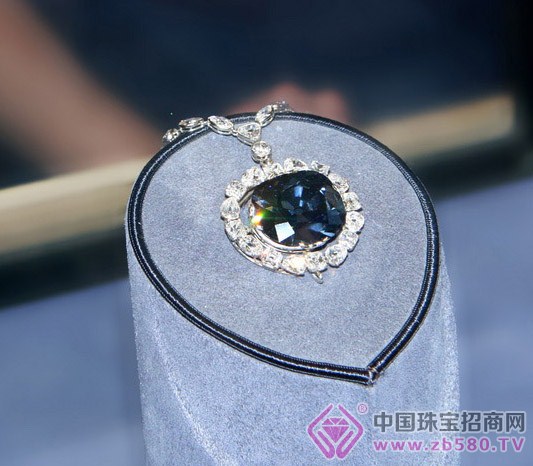Hope the true history of diamonds

French Blue
In fact, the diamond was bought by Tavenier in the famous Koror mine in Golconda, India, around 1660, when it was called the blue of Taverini. At that time, the diamond was only roughly carved into a triangular shape, so it could not be regarded as the goddess' eyes.
In 1668, Tavenier returned to France to show his harvest in India to King Louis XIV at the Palace of Versailles. Louis XIV bought more than forty large diamonds, including this blue diamond. The royal jeweler Sieur Pitau cut it into 67.125 carats, set it on a gold base, and attached it to the ribbon as a king's item at the ceremony. Louis XIV called it the crown blue diamond or the blue of France. In 1749, Louis XV cut the drill and placed it on its own gold wool medal as a pendant. After the death of Louis XV, the diamond was not officially used.
During the French Revolution, Louis XVI and Mary Anthony were detained and they did not carry the gem with them. On September 11, 1792, six thieves broke into the royal treasure house and stole the drill. One of the thieves, Cadet Guillot, took him back to Le Havre and crossed the sea to London. In 1796, Guillot was arrested and arrested by Lancrydela Loyelle. Gulliot is said to have dedicated the diamond to dela Loyelle, but no material has documented this.
In September 1812, a diamond similar to the French blue appeared in the hands of London jeweler Daniel Eliassen, the source of hope that diamonds can be verified at the earliest. In February 2005, American scientists confirmed that the diamond was indeed cut from the blue of France. At this time, it was just 20 years since the blue of France was stolen, just exceeding the time limit for prosecution prescribed by law. Legend has it that George IV once owned it, but there is no record in the royal archives of Windsor Castle.
Hope family
In 1824, the diamond appeared in the collection of Henry Phillip Hope, who put it on a brooch, and his sister-in-law often wore the blue diamond to attend a social gathering. In 1839, Hope died, his three nephews fought for ten years in order to fight for his legacy, and finally Henry Hope won the diamond. Since then, the diamond has been exhibited at the London World Exposition in 1851 and the 1855 Paris World Exposition.
Henry Hope died on December 4, 1862, and his wife inherited his property. On March 31, 1884, Mrs. Hope passed away, and his grandson, Henry Francis Hope Pellham-Clinton Hope, and the sixth Duke of Newcastle, won the diamond in 1887. But according to the will, he can't sell it.
The Duke squandered and went bankrupt. In 1894 he married American actress May Yohe and earned a living by his wife. In 1896, the Duke went bankrupt and had to apply for an auction of diamonds. In 1901, the British House of Lords finally ruled that he could sell hope diamonds.
Flowing to the United States
London jeweler Adolf Weil bought the diamond of hope for £29,000 and then handed it to American Simon Frankel. In 1908, Salomon Habib of Paris bought the diamond for $400,000. In 1909, Habib, who was in deep debt crisis, was forced to sell the diamond to Rosenau in Paris at a low price ($800,000). In 1910, the famous jeweler Pier Cartier purchased it for 550,000 francs.
Cartier re-inlaid the jewel and sold it to Macleans in 1911. McLean died in 1947. In 1949, he hoped that the diamond would be auctioned again, and New York jeweler Winston bought it. Winston exhibited the diamond tour and exhibited it in many public events, including the 1958 Canadian National Exposition. On November 7, 1958, Winston would like to donate diamonds to the Smithsonian Museum.
Smithsonian years
It may be true that this diamond has brought bad luck to some people, but for Smithsonian, possessing this diamond means good luck. Hope that diamonds are an important exhibit of its jewelry pavilion. In 1962, the museum rebuilt the jewellery pavilion and dedicated a small hall to display the diamond. The diamond is displayed on a rotating base and attracts a large number of visitors every day. It is the most popular exhibit of the museum.
Latest research
In recent research, researchers have called their color "wonderful dark gray blue." This diamond has a unique fluorescence. Like other gems, it glows lightly under ultraviolet light, but when the ultraviolet light source is removed, the diamond emits bright red phosphorescence. And a small diamond next to it emits white-blue phosphorescence after irradiation.
Backing Scrim Fabric For Engineering Vinyl Wallcovering
Scrim Vinyl Wallpaper,Mesh Greige Fabric,Pvc Backing Polyester Fabric,Primary Backing Cloth Fabric
Nantong Guanheng Textile Co.,Ltd , https://www.ntghfabric.com
